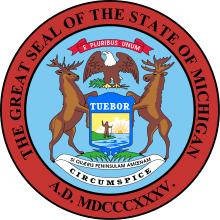Baraga County, Michigan
Baraga County (/ˈbɛərəɡə/ BAIR-ə-gə) is a county in the Upper Peninsula in the U.S. state of Michigan. As of the 2010 census, the population was 8,860.[3] The county seat is L'Anse.[4] The county is named after Bishop Frederic Baraga, a Catholic missionary who ministered to indigenous peoples in the Michigan Territory.[1]
Baraga County | |
|---|---|
Baraga County Courthouse and Annex (July 2014) | |
Seal | |
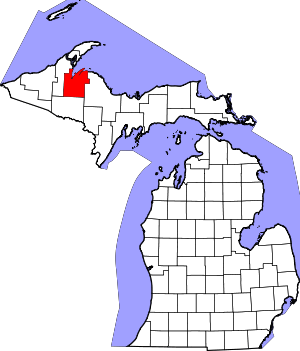 Location within the U.S. state of Michigan | |
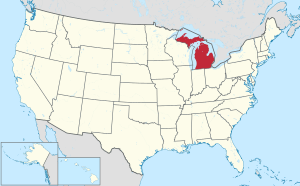 Michigan's location within the U.S. | |
| Coordinates: 46°43′N 88°20′W | |
| Country | |
| State | |
| Founded | February 19, 1875[1][2] |
| Named for | Frederic Baraga |
| Seat | L'Anse |
| Largest village | Baraga |
| Area | |
| • Total | 1,069 sq mi (2,770 km2) |
| • Land | 898 sq mi (2,330 km2) |
| • Water | 171 sq mi (440 km2) 16%% |
| Population | |
| • Estimate (2018) | 8,320 |
| • Density | 9.9/sq mi (3.8/km2) |
| Time zone | UTC−5 (Eastern) |
| • Summer (DST) | UTC−4 (EDT) |
| Congressional district | 1st |
The L'Anse Indian Reservation of the Ojibwa is within Baraga County.
Geography
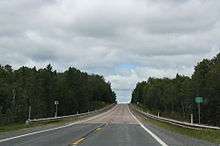
According to the U.S. Census Bureau, the county has a total area of 1,069 square miles (2,770 km2), of which 898 square miles (2,330 km2) is land and 171 square miles (440 km2) (16%) is water.[5]
The county is located in the state's Upper Peninsula on the shore of Lake Superior, at the southeast base of the Keweenaw Peninsula. The villages of Baraga and L'Anse are located at the base of Lake Superior's Keweenaw Bay. Point Abbaye projects north into the lake, enclosing Huron Bay. The eastern two-thirds of the county includes much of the Huron Mountains, including Mount Arvon—the highest natural point in Michigan at 1,979 feet (603 m).
Major highways




Adjacent counties
- Marquette County (east)
- Iron County (south)
- Houghton County (west)
National protected areas
- Keweenaw National Historical Park (part)
- Ottawa National Forest (part)
Demographics
| Historical population | |||
|---|---|---|---|
| Census | Pop. | %± | |
| 1880 | 1,804 | — | |
| 1890 | 3,036 | 68.3% | |
| 1900 | 4,320 | 42.3% | |
| 1910 | 6,127 | 41.8% | |
| 1920 | 7,662 | 25.1% | |
| 1930 | 9,168 | 19.7% | |
| 1940 | 9,356 | 2.1% | |
| 1950 | 8,037 | −14.1% | |
| 1960 | 7,151 | −11.0% | |
| 1970 | 7,789 | 8.9% | |
| 1980 | 8,484 | 8.9% | |
| 1990 | 7,954 | −6.2% | |
| 2000 | 8,746 | 10.0% | |
| 2010 | 8,860 | 1.3% | |
| Est. 2018 | 8,320 | [6] | −6.1% |
| US Decennial Census[7] 1790-1960[8] 1900-1990[9] 1990-2000[10] 2010-2018[3] | |||
The 2010 United States Census[11] indicates Baraga County had a population of 8,860. This increase of 114 people from the 2000 United States Census. is a 1.3% population growth. In 2010 there were 3,444 households and 2,209 families in the county. The population density was 10 people per square mile (4/km²). There were 5,270 housing units at an average density of 6 per square mile (2/km²). 75.0% of the population were White, 13.1% Native American, 7.2% Black or African American, 0.1% Asian, 0.2% of some other race and 4.4% of two or more races. 1.0% were Hispanic or Latino (of any race). 22.5% were of Finnish, 9.1% German, 8.8% French, French Canadian or Cajun, 5.6% English and 5.5% Irish ancestry.[12]
There were 3,444 households out of which 25.2% had children under the age of 18 living with them, 47.4% were married couples living together, 10.9% had a female householder with no husband present, and 35.9% were non-families. 31.6% of all households were made up of individuals and 13% had someone living alone who was 65 years of age or older. The average household size was 2.28 and the average family size was 2.82.
The county population contained 20.2% under the age of 18, 7% from 18 to 24, 25.7% from 25 to 44, 29.7% from 45 to 64, and 17.2% who were 65 years of age or older. The median age was 42.9 years. 54.9% of the population was male, 45.1% was female.
The median income for a household in the county was $40,115, and the median income for a family was $50,996. The per capita income for the county was $19,076. About 9.5% of families and 13% of the population were below the poverty line, including 19.2% of those under age 18 and 6.7% of those age 65 or over.
Government
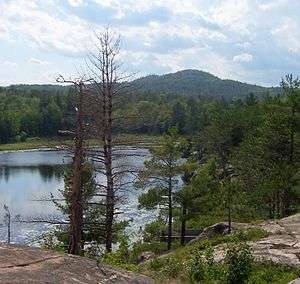
Baraga County has tended to vote Republican through the years. Since 1884 its voters have selected the Republican Party nominee in 64% (22 of 34) of the national elections through 2016.
| Year | Republican | Democratic | Third Parties |
|---|---|---|---|
| 2016 | 61.3% 2,158 | 32.9% 1,156 | 5.8% 204 |
| 2012 | 53.5% 1,866 | 45.1% 1,574 | 1.4% 50 |
| 2008 | 50.5% 1,846 | 47.2% 1,725 | 2.2% 82 |
| 2004 | 53.7% 1,977 | 45.1% 1,660 | 1.3% 47 |
| 2000 | 54.1% 1,836 | 41.3% 1,400 | 4.6% 157 |
| 1996 | 36.7% 1,209 | 48.6% 1,601 | 14.7% 484 |
| 1992 | 32.0% 1,160 | 46.7% 1,695 | 21.4% 775 |
| 1988 | 47.9% 1,630 | 51.5% 1,753 | 0.6% 21 |
| 1984 | 51.8% 1,965 | 47.9% 1,818 | 0.2% 9 |
| 1980 | 52.2% 2,046 | 41.0% 1,609 | 6.8% 266 |
| 1976 | 49.5% 1,788 | 49.2% 1,778 | 1.3% 48 |
| 1972 | 54.9% 1,905 | 43.7% 1,517 | 1.3% 46 |
| 1968 | 45.5% 1,508 | 50.6% 1,680 | 3.9% 130 |
| 1964 | 31.1% 1,160 | 68.7% 2,568 | 0.2% 8 |
| 1960 | 48.5% 1,861 | 51.2% 1,964 | 0.3% 11 |
| 1956 | 55.5% 1,968 | 44.4% 1,574 | 0.1% 3 |
| 1952 | 57.3% 2,103 | 42.0% 1,540 | 0.8% 28 |
| 1948 | 50.1% 1,878 | 44.2% 1,656 | 5.7% 214 |
| 1944 | 49.3% 1,829 | 50.5% 1,874 | 0.3% 11 |
| 1940 | 53.5% 2,512 | 45.8% 2,152 | 0.7% 33 |
| 1936 | 46.9% 2,035 | 51.2% 2,218 | 1.9% 82 |
| 1932 | 46.9% 1,917 | 49.3% 2,016 | 3.7% 153 |
| 1928 | 65.3% 2,203 | 31.0% 1,046 | 3.7% 126 |
| 1924 | 71.8% 1,714 | 8.7% 208 | 19.5% 464 |
| 1920 | 74.7% 1,368 | 16.6% 304 | 8.7% 160 |
| 1916 | 57.2% 748 | 35.3% 462 | 7.5% 98 |
| 1912 | 26.0% 295 | 24.7% 280 | 49.4% 561 |
| 1908 | 74.0% 765 | 22.4% 232 | 3.6% 37 |
| 1904 | 73.3% 564 | 24.1% 185 | 2.6% 20 |
| 1900 | 63.9% 606 | 35.1% 333 | 1.0% 9 |
| 1896 | 55.9% 611 | 42.0% 459 | 2.1% 23 |
| 1892 | 36.8% 375 | 61.8% 630 | 1.5% 15 |
| 1888 | 48.7% 389 | 50.8% 406 | 0.5% 4 |
| 1884 | 56.3% 396 | 43.7% 307 | 0.0% 0 |
Baraga County operates the County jail, maintains rural roads, operates the major local courts, records deeds, mortgages, and vital records, administers public health regulations, and participates with the state in the provision of social services. The county board of commissioners controls the budget and has limited authority to make laws or ordinances. In Michigan, most local government functions – police and fire, building and zoning, tax assessment, street maintenance etc. – are the responsibility of individual cities and townships.
Communities
Census-designated place
Other unincorporated communities
- Alberta
- Arnheim
- Arvon
- Assinins (called Fewsville 1872-1894)
- Aura
- Bear Town
- Beaufort Lake
- Covington
- Herman
- Huron Bay
- Imperial Heights
- Keweenaw Bay
- Laughs Lake
- McComb Corner
- Nestoria
- Pelkie
- Pequaming
- Saint Cyr
- Skanee
- Summit
- Three Lakes
- Tioga
- Tunis
- Vermilac
- Watton
Indian reservations
- The L'Anse Indian Reservation occupies two sections of Baraga County within portions of Baraga, L'Anse, and Arvon townships. The reservation also has very small portion in Chocolay Charter Township in neighboring Marquette County to the east.
See also
- List of Michigan State Historic Sites in Baraga County, Michigan
- National Register of Historic Places listings in Baraga County, Michigan
References
- "Bibliography on Baraga County". Clarke Historical Library, Central Michigan University. Retrieved January 19, 2013.
- "jengod.com".
- "State & County QuickFacts". US Census Bureau. Retrieved August 26, 2013.
- "Find a County". National Association of Counties. Retrieved June 7, 2011.
- "2010 Census Gazetteer Files". US Census Bureau. August 22, 2012. Retrieved September 19, 2014.
- "Population and Housing Unit Estimates". Retrieved May 16, 2019.
- "US Decennial Census". US Census Bureau. Retrieved September 19, 2014.
- "Historical Census Browser". University of Virginia Library. Retrieved September 19, 2014.
- "Population of Counties by Decennial Census: 1900 to 1990". US Census Bureau. Retrieved September 19, 2014.
- "Census 2000 PHC-T-4. Ranking Tables for Counties: 1990 and 2000" (PDF). US Census Bureau. Retrieved September 19, 2014.
- "U.S. Census website". Retrieved July 6, 2013.
- Data Access and Dissemination Systems (DADS). "U.S. Census website". census.gov.
- US Election Atlas
External links
- Baraga County Government website
- Baraga County Profile, Sam M Cohodas Regional Economist
- Western Upper Peninsula Planning & Development Region
